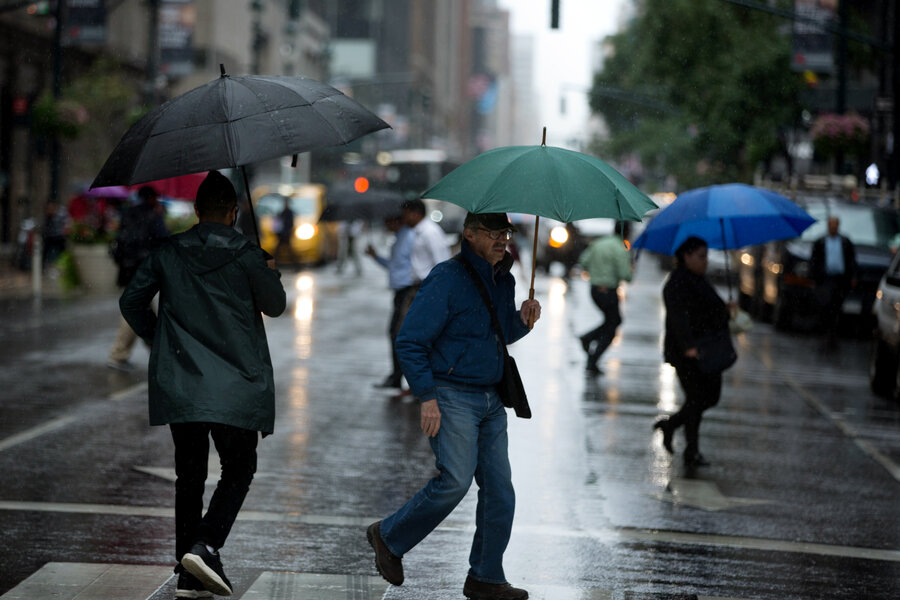More rain, flooding forecast along soggy East Coast
Loading...
Unrelenting rain across the East Coast showed little sign of letup early Saturday, with record-setting precipitation expected to prolong the soppy misery that has been eased only by news that Hurricane Joaquin is no longer a threat.
A flash flood warning was in effect in parts of South Carolina, where authorities shut down the Charleston peninsula to motorists.
Several feet of water had caused vehicles to stall in downtown Charleston and water has inundated some homes and buildings in the area, according to the National Weather Service. At least two to four additional inches of rain was expected by noon. Barbara Vaughn, a Charleston city spokeswoman, said several people were rescued from stranded cars there.
The Charleston Police Department has issued lists of dozens of street closings, and the city's historic district was almost entirely shut down. Parts of the market area had sandbags piled up to keep the floodwaters out.
Portions of some streets were flooded, with water roughly 8 to 12 inches deep, reaching the wheel wells of cars in some spots. Police have stationed officers and set up barricades all over the city blocking roads. No one is being allowed into Charleston, and once people drive out, they won't be allowed back in until the flooding subsides.
In one area, water swirled like a toilet down a storm drain. Public works crews patrolled the city, checking storm drains in case they needed to be cleared of debris.
Elsewhere, coastal flooding remained a threat — particularly in the Virginia Beach area and the Outer Banks of North Carolina. The weather service issued a warning for residents living along the coast to be alert for rising water. A combination of high water and high waves could result in beach erosion and damage to docks and piers.
The National Weather Service in Greenville said that "bursts of heavy rain are likely" in the Carolinas and parts of northern Georgia that could cause rivers and streams in the region to flood significantly.
The rain levels had the potential to be "life threatening and historic," the service said on its website.
Once the rain ends, the threat of flooding persists because the ground is too saturated to absorb water, meteorologists say. And high winds could bring down trees like the one that hit a vehicle near Fayetteville, North Carolina, killing a passenger.
The storm also has been linked to a drowning in Spartanburg, South Carolina.
Flood watches and warnings also are in effect in Delaware and parts of New Jersey, Maryland and Virginia.
In New Jersey, storms dislodged an entire house from its pilings in a low-lying area of Middle Township. The remnants of the home could be seen in Grassy Sound after daybreak Saturday. The house was unoccupied.
Officials in southern Delaware were keeping a close eye on high tides that could exacerbate existing flooding of low-lying roads and properties. They said Saturday's high tide cycles could be as high as those on Friday, which left standing water in low-lying coastal areas and led to several road closures.
Continued onshore winds, with gusts of up to 40 mph, have kept the flood waters from receding, a problem that could last through the weekend.
However, the Carolinas will probably get the worst of it, including possible landslides in the mountains, experts said.
"It's going to be a slow-motion disaster," said meteorologist Ryan Maue of Weather Bell Analytics.
Hurricane Joaquin, no longer seen as a danger to the Atlantic Seaboard, continued Friday on a path expected to keep it well off the U.S. coast.
"It looks like we dodged a bullet this time," New Jersey Gov. Chris Christie said amid street flooding at the Jersey shore, devastated by Superstorm Sandy nearly three years ago. "Let's keep our fingers crossed."
Forecasters warned that even as Joaquin peels away from the coast, its effects will be felt, because it will continue supplying tropical moisture to the gusty rainstorm stretching from Georgia to New England.
South Carolina could get more rain in three days than it normally gets during the entire fall.
"We are growing increasingly concerned about the situation in South Carolina, western North Carolina and perhaps even in northeast Georgia," said David Novak, director of the National Oceanic and Atmospheric Administration's Weather Prediction Center. "We're pretty confident that some places are going to have 15 inches."
The storm was blamed for the death of Sylvia Arteaga, 56, drowned in a flash flood under a railroad bridge in Spartanburg, South Carolina, while driving home from the night shift.
Steve Stougard of Norfolk, Virginia, called Joaquin's course "an answered prayer."
Joaquin tore off roofs, uprooted trees and unleashed heavy flooding in the Bahamas, and the U.S. Coast Guard searched for a missing 735-foot cargo ship with 33 people aboard.
___
Dishneau reported from Chincoteague, Virginia; Borenstein from Washington.
___
Associated Press writers Jonathan Drew in Raleigh, North Carolina; Tom Foreman Jr. in Spartanburg, South Carolina; Wayne Parry in Sea Isle City, New Jersey; Alanna Durkin in Poquoson, Virginia; and Ben Nuckols in Washington contributed to this report.







